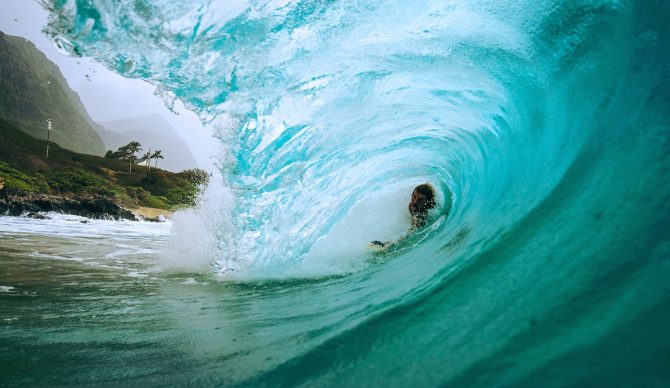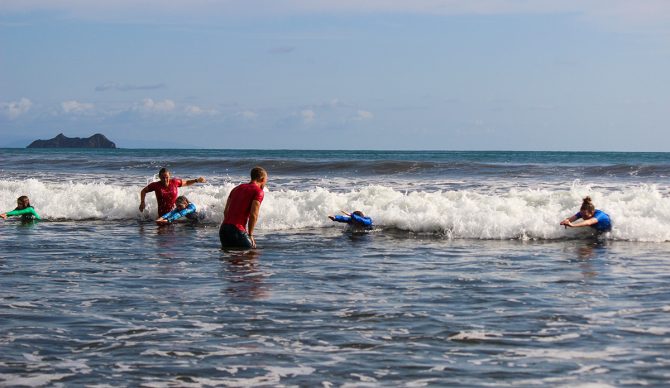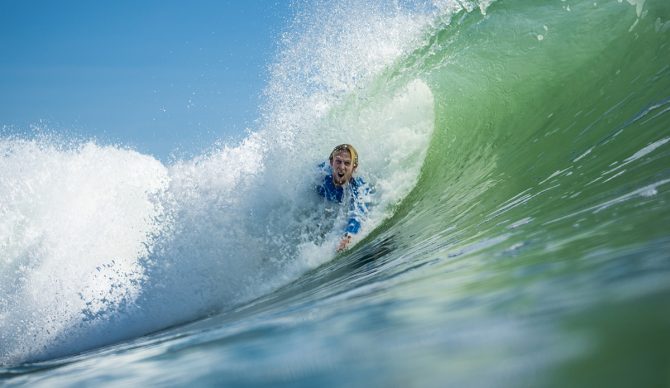
Photo: Drew Farwell / Unsplash
As someone who had the good fortune of being introduced to the ocean at a young age, I spent hundreds of hours bodysurfing and boogie boarding as a child before ever standing on a surfboard. Like I said, it’s good fortune, but it also means I grew up with no personal frame of reference for what it’s like to learn to ride waves as an adult.
Considering the ocean is a powerful and foreign environment far outside the human species’ comfort zone — an environment our bodies aren’t built to function in optimally — I can imagine learning to surf at a later stage in life could be overwhelming for some. Actually, as someone who earns a living teaching people to surf, I know it is. I’ve seen the stress-inducing scenarios play out time and time again, guiding people who are timid or unfamiliar with the ocean to a place where they can eventually feel confident and secure in the water.
It begs the question: Why don’t surf schools teach their students simpler methods of wave-riding, like bodysurfing, before taking on the task of getting them to stand on a board at the end of a two-hour lesson? Few things in life are as challenging as teaching somebody to maneuver a nine-foot board through the impact zone when that person has little or no experience in the ocean to begin with.
According to Matt Warshaw’s Encyclopedia of Surfing, “prior to the invention of the surf leash in the 1970s, all surfers were adept bodysurfers, as nearly every wipeout was followed by a bodysurfing ride to the beach to pick up the lost board.”
The simple invention of the ankle leash has allowed surfers to navigate the ocean without ever needing to experience chasing after a lost board, and by happenstance, it’s rendered bodysurfing a non-essential pastime instead of a necessary prerequisite. Nowadays, what once was a simple and fun ride to the beach can be a potentially scary, even dangerous situation for the majority of surfers when a leash breaks.

The exception to the rule when it comes to surf instruction. Photo: Bodhi Awaken
The sad truth is that surfing is sexy, it’s marketable, and it’s culturally significant. Bodysurfing is not. The typical landlubber paying for a surf lesson isn’t interested in building a strong foundation of ocean safety and savvy first – they’re eager to skip ahead to the “good stuff.” They want to paddle into a wave with a board under their chest. They want to get to their own two feet and ride that wave. However, anybody who surfs knows this very expectation is unrealistic because well, surfing is difficult. It takes place in an unpredictable, always-changing environment. The learning curve is very steep. And learning any new skill in life requires deliberate practice and repetition over time — something that can be a challenge to find in a constantly shifting playing field like the ocean. It’s not like playing basketball, where you can practice your free throws and count on the hoop being in the same place, sitting at the same height, every single time you take a shot.
Surfing, on the other hand, requires at least a base level of ocean knowledge to go along with athleticism and physical capability. The more you understand waves and how they function, the better surfer you will become. Bodysurfing is a great way to grow in this area. It teaches a person to observe waves with nothing more than a pair of swim fins on their feet, more attuned to their immediate surroundings in the water in the absence of floating on top of a surfboard. Yes, even the slight height difference — a line of sight just a couple of feet above the water’s surface — has a profound impact on one’s awareness of their environment. As a result, a bodysurfer’s movement and positioning in the ocean is groomed with instincts.
In the process, learning to bodysurf becomes a stronger foundation for identifying the peak of a wave, maneuvering around other surfers, holding your breath underwater for extended periods of time, identifying potential hazards like rip currents, and staying calm in the presence of bigger waves—all things that will undoubtedly reduce the learning curve of riding a board.
If the goal of every surf school is to prepare students for autonomy then instructors need to teach their students how to handle a broken leash, how to navigate confidently with or without a board, and help them gain instinctive positioning in the lineup. I’ve actually applied this philosophy at my own surf school in Costa Rica, incorporating bodysurf lessons into a well-rounded two-week surf camp curriculum. I’d like to see more surf schools follow.
Editor’s Note: Spencer Dunlap is an experienced instructor behind Bodhi Awaken, a two-week surf school and retreat based in Costa Rica. Learn more about his work here.

The author, practicing what he preaches. Photo: Bodhi Awaken

